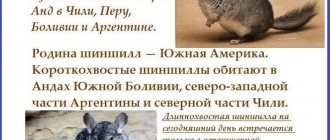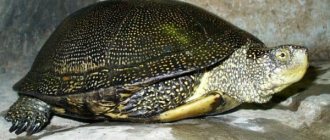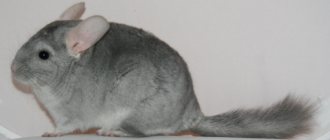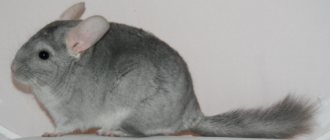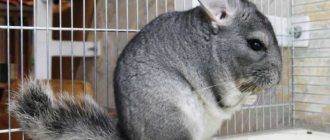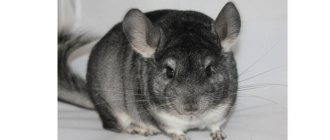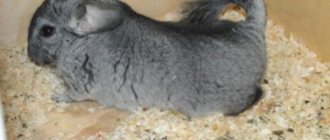Even in ancient times, people, realizing how useful animals can be, began to domesticate them. Among pets, there are those that we get for our benefit, and there are pets for the soul.
Often, pets become so close to us that we treat them as members of our family.
Nowadays, it is difficult to surprise anyone with the presence of an exotic animal in the house. And you definitely won’t surprise anyone with a funny animal, a chinchilla. But just recently this exotic animal was wild.
Description of chinchilla
The chinchilla's appearance makes it look like a large squirrel. These animals have very soft fur, large eyes and ears.
The chinchilla has a long tail (up to 17 centimeters). The hind limbs are longer than the front limbs and have a different number of fingers (on the hind limbs - 4, on the front - 5).
Chinchillas' teeth (20 of them) grow throughout their lives, so pets are noticed that they are constantly gnawing on something.
Diseases: how dangerous they are and how to treat them
These animals have strong immunity, which is why, with proper care, they rarely get sick. But being in unfavorable conditions can negatively affect their well-being. If the animal experiences a loss of appetite and decreased activity, this is a cause for concern. The following diseases are typical for chinchillas:
- Bronchopneumonia is accompanied by fever, difficulty breathing, nasal discharge, cough and wheezing. The animal is treated with glucose and vitamins. And also small doses of penicillin. This drug is prescribed intramuscularly once every three days. The dosage must be agreed with your veterinarian.
- Rectal prolapse. This causes constipation. The fallen part is first treated with furatsilin solution, then with paraffin oil and, using a pipette, carefully set.
- Formation of hair rings around the male genitals. This prevents it from reproducing. The rings are removed by hand. If they are dry, they are treated with a soap solution.
- Constipation. It can be caused by a lack of fluid and changes in diet. If there is such a problem, dry food is excluded. The pet is given a laxative and paraffin-based oil is injected into the mouth or rectum.
- Keratitis is a lesion of the cornea of the eyes. The disease occurs due to contact of the chinchilla with poor-quality sand or mechanical damage. The eyes are washed with furatsilin and treated with levomecithin or tetracycline ointment.
- Dental diseases occur when there is no stone to grind down. The animal's incisors reach 8 cm and injure the tongue. The molars move. The chinchilla is unable to eat and dies. Treatment involves grinding down the teeth, but this procedure must be performed by a veterinarian.
- Conjunctivitis manifests itself as purulent or clear discharge from the eyes. May indicate the presence of an infection. The animal's eyes are instilled with fluorescent, then treated with eye ointment every hour.
- Ticks. They can be detected after careful observation of the animal. The chinchilla's skin peels off and becomes thicker, and the animal suffers from itching. The animal loses weight, and in the absence of adequate treatment, dies. The wool needs to be cut, and the affected areas should be treated with bromocyclene at intervals of 8 days. The dosage is prescribed by the veterinarian. You will also need to disinfect the cage.
- Flatulence occurs as a result of feeding poor quality food. The animal's temperature drops to 34.5°C, and its general condition worsens. The animal is given activated carbon in powder form. You can use dill water or chamomile infusion. It is better to coordinate treatment with your veterinarian.
- Otitis is an inflammatory process that affects the external auditory canal. It is the result of pollution. The disease can be detected by the leaking brown liquid. The ear is treated with fish oil and ointment containing zinc.
- Diarrhea – occurs due to stress and unbalanced nutrition. The animal's temperature rises. He is given oak bark, maple leaves and activated carbon.
- Heatstroke. This ailment can be recognized by observing the behavior and appearance of the animal. It lies on its side, the ears turn red, and copious amounts of saliva appear. The chinchilla is moved to a cool place and a cold object is placed in the cage. For example, a bottle filled with cold water.
- Ringworm – baldness appears on the back, sides, head, neck and tail. The skin peels and becomes inflamed. The animal is treated with a 5% iodine solution, medical sulfur or fungistop.
Varieties of chinchillas
There are short-tailed and long-tailed chinchilla breeds. The first are very rare, since it was their fur that was most valued and they were almost completely exterminated.
Long-tailed individuals form in small groups and coexist successfully in the wild.
Interesting facts about the rodent:
Chinchilla looking at the camera
- The word "chinchilla" comes from the name of the Peruvian province of Chincha, which is located in Peru.
- The vocal behavior of chinchillas is very interesting. If they don't like something, they make a sound that resembles a quack or chirp. Very angry chinchillas begin to growl and, as it were, “blow their nose,” quickly clicking their teeth. If the animal gets hurt or gets very scared, it begins to squeak loudly. When threatened, chinchillas attack, stand on their hind legs, growl and let out a stream of urine, and then can grab the offender with their teeth.
- The use of chinchillas as a source of valuable fur in Europe and North America began in the 19th century, but a high demand for their skins still exists today. You need to spend about 100 skins on one fur coat, which is why chinchilla fur coats are the rarest and most expensive. For example, in 1928, the cost of a chinchilla coat was half a million gold marks. And in 1992, a chinchilla fur coat cost $22,000.
- The long-tailed chinchilla is kept as a pet and is also bred for fur on special farms and in private households. The fur of the long-tailed chinchilla is grayish-bluish in color, very soft, thick, and durable. The short-tailed chinchilla's fur is of slightly lower quality.
Character of chinchillas
Chinchillas have a very affectionate character. They gladly go into a person's arms and rarely attack. Most often, chinchilla bites are provoked by severe fright of the animal.
If you decide to buy a chinchilla as a pet, then during the first week you should leave it alone and give it time to get used to its new place of residence.
Creating a trusting relationship with your pet can begin with giving treats. If the chinchilla is ready to interact, then it will approach itself. Patience is important here.
However, despite its pride, at home the chinchilla is afraid of loneliness and can be very offended by the owner for a long separation.
Animal Reproduction
A pregnant female carries children for about 120 days, during which time she gains weight well. There can be from 1 to 6 children in a litter.
An interesting fact is that after giving birth on the same day, the female begins to demand a male for the next fertilization. It’s up to you to decide whether to add a male or not, but you need to adhere to the rule: no more than two births per year. A larger amount puts a greater burden on the female’s body.
During the first days after birth, children eat only mother's milk. But in a female, not all mammary glands work, but only the first pair, very rarely - two pairs. Stronger children push away weaker ones, and there are often fights between them. In such cases, you must either ensure that all children receive milk and control this process, or feed them with artificial formula from a bottle.
Breastfeeding can last up to two months, then the grown-up offspring completely switches to an adult diet.
Photo of chinchilla
Which breed is better to choose?
There are no clear recommendations regarding which breed of chinchilla is best to choose. This comes down to personal preference:
- lovers of furry pets should prefer the Angora breed;
- those who prefer miniature animals will like dwarf chinchillas;
- breeders who are crazy about rare exclusive breeds should pay attention to the violet, blue or pink diamond;
- Ebony chinchillas are ideal for professional breeders attending exhibitions;
- For those who do not want to spend money on purchasing a rare breed pet, it is better to pay attention to the standard.
The main thing to consider when choosing is the health of the animal. And both physical and psychological. If the animal is active, shows curiosity, has shiny fur without bald spots, everything is fine.
If the fluffy hid in the corner of the cage, or, conversely, shows aggression, it is better to go shopping to another nursery. Signs such as runny nose and eyes, dull fur, bad breath, and rotten teeth may also indicate an animal’s illness.
Regardless of the breed, any chinchilla needs the care and love of its owner. Only by feeling the warm attitude of the owner and living in good conditions, the pet will feel comfortable and confident. And most importantly, he will reciprocate the owner’s gratitude.
From whom did they come?
The prehistoric ancestors of chinchillas are considered to be animals called Meegamys by scientists. Their fossilized remains were found during excavations in the habitats of modern rodents. The age of the finds is about 40 thousand years. The biological structure of Meegamys is similar to chinchillas, but their size is much larger.
Based on the results of the excavations, a hypothesis was built that explains not only the origin of chinchillas, but also the unique properties of the animal’s fur. According to the researchers, during the process of evolution there was a gradual decrease in the size of individuals, but the number of hair follicles remained the same. As a result of these changes, the hair follicles on the skin of chinchillas are much denser than in other animals.
The closest relatives of chinchillas are porcupines, and the closest relatives in biological structure are considered to be viscacha, a genus from the chinchilla family.
Where do they live?
The historical homeland of the chinchilla is South America. Colonies of animals lived almost along the entire western coast. During the period of active trapping of fur-bearing animals, hunters burned vegetation to get to their burrows and shelters. A significant decrease in the number of animals, as well as the destruction of some plant species, reduced the habitat of the genus.
Currently, chinchillas are found only in central Chile, where the Chinchilla National Reserve was created in 1983 to preserve them.
Where do chinchillas live?
The usual habitat is mountainous terrain with little vegetation. Animals make shelters for themselves between stones, in crevices, caves; if necessary, they can dig a hole or make a home in the abandoned holes of other animals.
Natural enemies
In their natural habitat, rodents become food for foxes, snakes, and large birds of prey. Protection from enemies is the camouflage coloring of the fur, good reaction and coordination, and speed of movement. Hiding from persecution, chinchillas hide in crevices and voids. The structural features of the skeleton enable the animal to penetrate narrow openings and crevices. Another unique feature of the chinchilla is that it can literally shoot out tufts of fur, discarding it in the place where the predator has grabbed hold.
A LION



